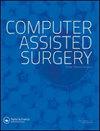磁感应测量仿真中具有真实解剖结构和六面体离散特征的改进的10组织人头模型
IF 1.9
4区 医学
Q3 SURGERY
引用次数: 2
摘要
磁感应测量(MIM)是一种很有前途的生物医学技术,可用于颅脑疾病的检测和监测。为了达到MIM仿真的目的,需要一个具有真实解剖结构的人体头部模型。然而,MIM仿真中使用的接近解剖真实的模型在随后的有限元方法计算中使用四面体单元进行离散化。第三军医大学提供的头部模型是目前唯一适用于六面体离散化和有限差分积分计算的模型。尽管如此,这个模型还是有一些缺陷。为了解决这些问题,我们构建了一个具有真实解剖结构和六面体离散特征的改进的10组织人头模型。本文详细介绍了新水头模型构建的操作和优化方法。我们使用10组织头部模型对我们之前发表的文章中描述的磁感应传感器进行了时间敏感性仿真,并将仿真数据与基于TMMU头部模型的仿真数据进行了比较。结果表明,新头部模型具有更高的时间灵敏度,在MIM仿真中具有更好的性能。本文章由计算机程序翻译,如有差异,请以英文原文为准。
An improved 10-tissue human head model with real anatomical structure and hexahedral discretization feature in magnetic induction measurement simulation
Abstract Magnetic induction measurement (MIM) is a promising technique for biomedical applications in craniocerebral disease detection and monitoring. For the purposes of the MIM simulation, a human head model with real anatomic structure is required. However, nearly anatomically realistic models used in the MIM simulations are discretized using tetrahedral elements of subsequent finite elements method computation. The head model supplied by the Third Military Medical University (TMMU) is currently the only model suitable for hexahedral discretization and finite difference/integral computation. This model has nonetheless number of defects. In order to deal with these, we construct an improved 10-tissue human head model with real anatomical structures and hexahedral discretization features. In this paper, the operation and optimization methods used to construct for the new head model are presented and discussed in detail. We use the 10-tissue head model to conduct the time sensitivity simulation of the magnetic induction sensor which was described in our previous publication and compare the simulation data with those based on the TMMU’s head model. The result shows that the new head model has a higher time sensitivity, meaning better performance in the MIM simulation.
求助全文
通过发布文献求助,成功后即可免费获取论文全文。
去求助
来源期刊

Computer Assisted Surgery
Medicine-Surgery
CiteScore
2.30
自引率
0.00%
发文量
13
审稿时长
10 weeks
期刊介绍:
omputer Assisted Surgery aims to improve patient care by advancing the utilization of computers during treatment; to evaluate the benefits and risks associated with the integration of advanced digital technologies into surgical practice; to disseminate clinical and basic research relevant to stereotactic surgery, minimal access surgery, endoscopy, and surgical robotics; to encourage interdisciplinary collaboration between engineers and physicians in developing new concepts and applications; to educate clinicians about the principles and techniques of computer assisted surgery and therapeutics; and to serve the international scientific community as a medium for the transfer of new information relating to theory, research, and practice in biomedical imaging and the surgical specialties.
The scope of Computer Assisted Surgery encompasses all fields within surgery, as well as biomedical imaging and instrumentation, and digital technology employed as an adjunct to imaging in diagnosis, therapeutics, and surgery. Topics featured include frameless as well as conventional stereotactic procedures, surgery guided by intraoperative ultrasound or magnetic resonance imaging, image guided focused irradiation, robotic surgery, and any therapeutic interventions performed with the use of digital imaging technology.
 求助内容:
求助内容: 应助结果提醒方式:
应助结果提醒方式:


